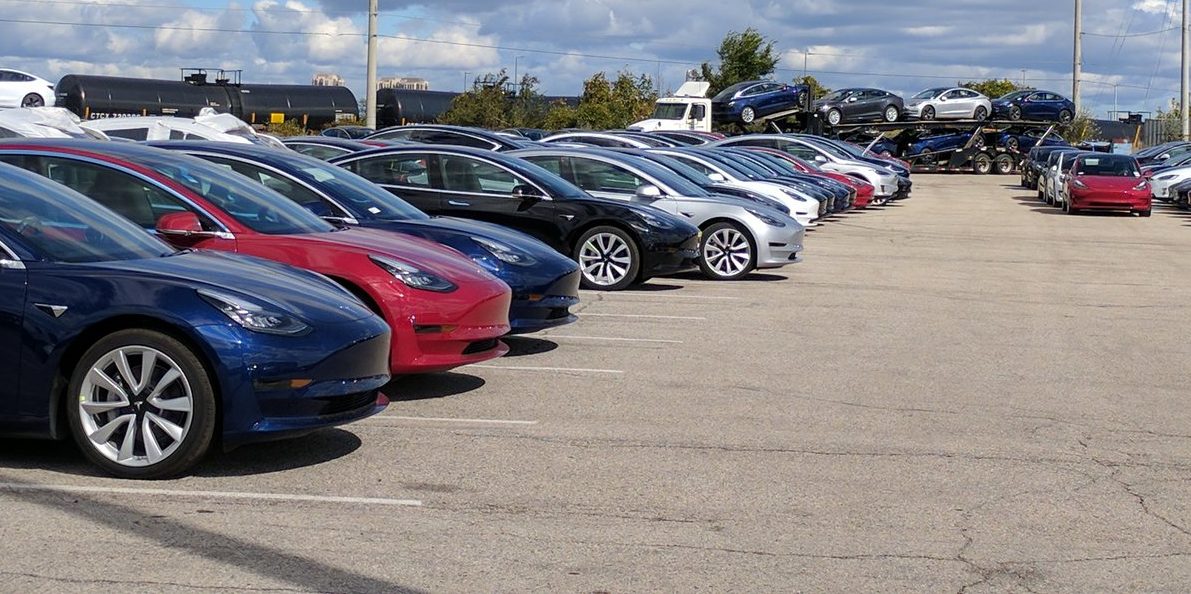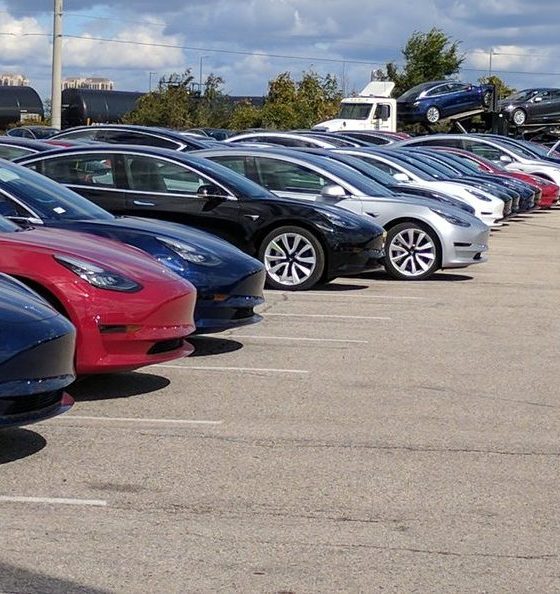

Investor's Corner
The Tesla Model 3’s effect on the oil industry gets recognized by Wall St veteran
The past year was historic for the electric car industry. In 2018, the Tesla Model 3, a car aptly dubbed by Elon Musk as a “bet-the-company” project, proved its naysayers wrong by establishing itself as the United States’ best-selling luxury vehicle with sales of 145,846 units over the year. That’s far above the sales of the next car on the list — the Lexus RX, which sold 111,641 units in 2018.
Amidst the ongoing EV revolution is the potential of a notable shift in the mindset of car buyers. With options like the Model 3 on the market, people that are shopping for cars are no longer limited to vehicles that are equipped with internal combustion engines. Gone are the days when electric cars were short-range and unappealing. With the Model 3, Tesla was able to offer a vehicle that is reasonably priced (especially in the case of the Mid Range variant), attractive, and still loaded with advanced features.
This has not gone unnoticed by one of Wall Street’s noted oil analysts, Stephen Schork. In an appearance at Fox Business, Schork, who is a veteran in the world of commodity and derivatives trading, pointed that the emergence of electric cars could very well be affecting the oil industry.
“My overarching concern right now is the economic development. Tesla put 150,000 new Model 3s on the market. That’s 150,000 cars that don’t consume gasoline. And it’s not just Tesla. Porsche, Audi, and BMW are all coming out with all-electric vehicles in 2019. So the inelasticities of demand in this market are fundamentally changing,” he said.
In a way, it is quite refreshing to see someone like Schork, who is well-versed in the oil industry, admit that initiatives such as the Model 3 are doing their part in the transition to cleaner mobility. If any, the addition of electric vehicles from other automakers such as Audi, Porsche, and Mercedes-Benz all but support Elon Musk’s primary goal for Tesla — to accelerate the world’s transition to sustainable energy.
In a way, Schork’s statements echo much of the insights of Mizuho Securities analyst Paul Sankey, who previously mentioned that the oil industry is feeling what could only be described as the “Tesla Effect.” While speaking to CNBC, Sankey stated that some of the challenges faced by the oil market have something to do with the public’s shifting perception towards oil itself.
“Essentially, the big issue is the so-called ‘Tesla Effect,’ the general ‘End of the Oil Age’ theme that is a problem for these (oil) stocks. As the oil price goes up, especially to the levels we’re at now and potentially beyond, it’s almost as if the Tesla Effect could be exacerbated by the potential for higher oil prices to accelerate the end of the Oil Age. The Tesla Effect is the overall concept that (while) the 20th century was driven by oil, the 21st century will be driven by electricity. There’s a 30-year transition, and we’re somewhere probably 10 years into that transition. Ultimately, (the) terminal value of oil has been severely affected by the potential for us to change behavior,” Sankey said.
What is particularly interesting is that Tesla is nowhere near complete in its ramp of the Model 3. Tesla eventually plans to produce 10,000 of the vehicle per week, and as of the fourth quarter, the company was reportedly peaking at just around 1,000 Model 3 per day. Needless to say, Tesla’s Model 3 push might be impressive already, but it is still just getting started.
Watch Stephen Schork’s segment on Fox Business in the video below.

Investor's Corner
Tesla stock closes at all-time high on heels of Robotaxi progress

Tesla stock (NASDAQ: TSLA) closed at an all-time high on Tuesday, jumping over 3 percent during the day and finishing at $489.88.
The price beats the previous record close, which was $479.86.
Shares have had a crazy year, dipping more than 40 percent from the start of the year. The stock then started to recover once again around late April, when its price started to climb back up from the low $200 level.
This week, Tesla started to climb toward its highest levels ever, as it was revealed on Sunday that the company was testing driverless Robotaxis in Austin. The spike in value pushed the company’s valuation to $1.63 trillion.
Tesla Robotaxi goes driverless as Musk confirms Safety Monitor removal testing
It is the seventh-most valuable company on the market currently, trailing Nvidia, Apple, Alphabet (Google), Microsoft, Amazon, and Meta.
Shares closed up $14.57 today, up over 3 percent.
The stock has gone through a lot this year, as previously mentioned. Shares tumbled in Q1 due to CEO Elon Musk’s involvement with the Department of Government Efficiency (DOGE), which pulled his attention away from his companies and left a major overhang on their valuations.
However, things started to rebound halfway through the year, and as the government started to phase out the $7,500 tax credit, demand spiked as consumers tried to take advantage of it.
Q3 deliveries were the highest in company history, and Tesla responded to the loss of the tax credit with the launch of the Model 3 and Model Y Standard.
Additionally, analysts have announced high expectations this week for the company on Wall Street as Robotaxi continues to be the focus. With autonomy within Tesla’s sights, things are moving in the direction of Robotaxi being a major catalyst for growth on the Street in the coming year.
Elon Musk
Tesla needs to come through on this one Robotaxi metric, analyst says
“We think the key focus from here will be how fast Tesla can scale driverless operations (including if Tesla’s approach to software/hardware allows it to scale significantly faster than competitors, as the company has argued), and on profitability.”

Tesla needs to come through on this one Robotaxi metric, Mark Delaney of Goldman Sachs says.
Tesla is in the process of rolling out its Robotaxi platform to areas outside of Austin and the California Bay Area. It has plans to launch in five additional cities, including Houston, Dallas, Miami, Las Vegas, and Phoenix.
However, the company’s expansion is not what the focus needs to be, according to Delaney. It’s the speed of deployment.
The analyst said:
“We think the key focus from here will be how fast Tesla can scale driverless operations (including if Tesla’s approach to software/hardware allows it to scale significantly faster than competitors, as the company has argued), and on profitability.”
Profitability will come as the Robotaxi fleet expands. Making that money will be dependent on when Tesla can initiate rides in more areas, giving more customers access to the program.
There are some additional things that the company needs to make happen ahead of the major Robotaxi expansion, one of those things is launching driverless rides in Austin, the first city in which it launched the program.
This week, Tesla started testing driverless Robotaxi rides in Austin, as two different Model Y units were spotted with no occupants, a huge step in the company’s plans for the ride-sharing platform.
Tesla Robotaxi goes driverless as Musk confirms Safety Monitor removal testing
CEO Elon Musk has been hoping to remove Safety Monitors from Robotaxis in Austin for several months, first mentioning the plan to have them out by the end of 2025 in September. He confirmed on Sunday that Tesla had officially removed vehicle occupants and started testing truly unsupervised rides.
Although Safety Monitors in Austin have been sitting in the passenger’s seat, they have still had the ability to override things in case of an emergency. After all, the ultimate goal was safety and avoiding any accidents or injuries.
Goldman Sachs reiterated its ‘Neutral’ rating and its $400 price target. Delaney said, “Tesla is making progress with its autonomous technology,” and recent developments make it evident that this is true.
Investor's Corner
Tesla gets bold Robotaxi prediction from Wall Street firm
Last week, Andrew Percoco took over Tesla analysis for Morgan Stanley from Adam Jonas, who covered the stock for years. Percoco seems to be less optimistic and bullish on Tesla shares, while still being fair and balanced in his analysis.

Tesla (NASDAQ: TSLA) received a bold Robotaxi prediction from Morgan Stanley, which anticipates a dramatic increase in the size of the company’s autonomous ride-hailing suite in the coming years.
Last week, Andrew Percoco took over Tesla analysis for Morgan Stanley from Adam Jonas, who covered the stock for years. Percoco seems to be less optimistic and bullish on Tesla shares, while still being fair and balanced in his analysis.
Percoco dug into the Robotaxi fleet and its expansion in the coming years in his latest note, released on Tuesday. The firm expects Tesla to increase the Robotaxi fleet size to 1,000 vehicles in 2026. However, that’s small-scale compared to what they expect from Tesla in a decade.
Tesla expands Robotaxi app access once again, this time on a global scale
By 2035, Morgan Stanley believes there will be one million Robotaxis on the road across multiple cities, a major jump and a considerable fleet size. We assume this means the fleet of vehicles Tesla will operate internally, and not including passenger-owned vehicles that could be added through software updates.
He also listed three specific catalysts that investors should pay attention to, as these will represent the company being on track to achieve its Robotaxi dreams:
- Opening Robotaxi to the public without a Safety Monitor. Timing is unclear, but it appears that Tesla is getting closer by the day.
- Improvement in safety metrics without the Safety Monitor. Tesla’s ability to improve its safety metrics as it scales miles driven without the Safety Monitor is imperative as it looks to scale in new states and cities in 2026.
- Cybercab start of production, targeted for April 2026. Tesla’s Cybercab is a purpose-built vehicle (no steering wheel or pedals, only two seats) that is expected to be produced through its state-of-the-art unboxed manufacturing process, offering further cost reductions and thus accelerating adoption over time.
Robotaxi stands to be one of Tesla’s most significant revenue contributors, especially as the company plans to continue expanding its ride-hailing service across the world in the coming years.
Its current deployment strategy is controlled and conservative to avoid any drastic and potentially program-ruining incidents.
So far, the program, which is active in Austin and the California Bay Area, has been widely successful.








